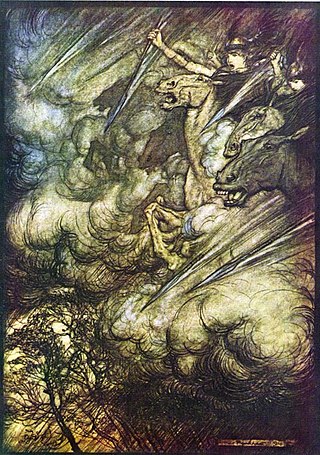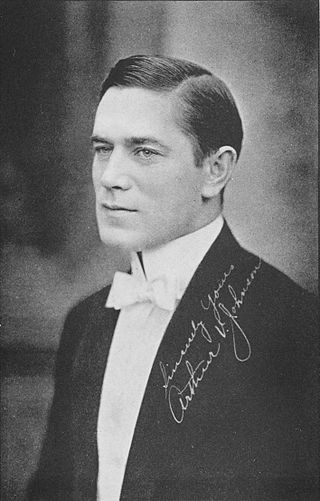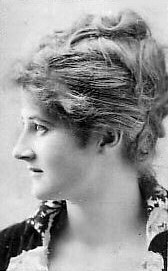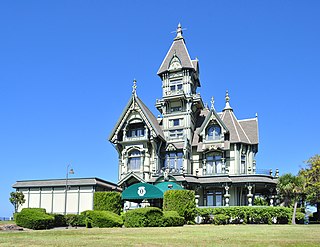
David Wark Griffith was an American film director. Considered one of the most influential figures in the history of the motion picture, he pioneered many aspects of film editing and expanded the art of the narrative film.
This article contains information about the literary events and publications of 1851.

Maria White Lowell was an American poet and abolitionist. Her poems were privately printed by her husband, James Russell Lowell, the poet, two years after her death.

The "Ride of the Valkyries" refers to the beginning of act 3 of Die Walküre, the second of the four operas constituting Richard Wagner's Der Ring des Nibelungen.

Julia Marlowe was an English-born American actress, known for her interpretations of William Shakespeare's plays.

Arthur Vaughan Johnson was a pioneer actor and director of the early American silent film era.

Mary Anderson was an American theatre actress.

Linda Arvidson was an American stage and film actress who became one of America's early motion picture stars while working at Biograph Studios in New York, where none of the company's actors, until 1913, were credited on screen. Along with Florence Lawrence, Marion Leonard, and other female performers there, she was often referred to by theatergoers and in trade publications as simply one of the "Biograph girls". Arvidson began working in the new, rapidly expanding film industry after meeting her future husband D. W. Griffith, who impressed her as an innovative screen director. Their marriage was kept secret for reasons of professional discretion.

Powhatan Beaty was an African American soldier and actor. During the American Civil War, he served in the Union Army's 5th United States Colored Infantry Regiment throughout the Richmond–Petersburg Campaign. He received America's highest military decoration, the Medal of Honor, for taking command of his company at the Battle of Chaffin's Farm, after all officers had been killed or wounded.
Brutality is a 1912 American drama film directed by D. W. Griffith. Prints and/or fragments were found in the Dawson Film Find in 1978.
Ingomar is an unincorporated community in Merced County, California. It is located on the Southern Pacific Railroad 10.5 miles (17 km) northwest of Los Banos, at an elevation of 92 feet.

The Ingomar Club is a private club that owns and is based in the historic Carson Mansion in Eureka, California, one of the most notable examples of Victorian architecture in the United States. According to researcher Wally Graves, the club was founded "to own and maintain a club headquarters for the meetings and enjoyment of its members; to create, establish and maintain an association of gentlemen for the preservation and protection of historic 'Carson Mansion'; to promote interest among its members in athletics, yachting, golf, swimming and related activities; to promote good fellowship, and to associate together those interested in the field of fine arts, music and culture" More recently, the club defines its mission as one of maintaining the historic home while providing dining and social outlets for its members.

The Carson Mansion is a large Victorian house located in Old Town, Eureka, California. Regarded as one of the premier examples of Queen Anne style architecture in the United States, the house is "considered the most grand Victorian home in America." It is one of the most written about and photographed Victorian houses in California and possibly also in the United States.

James Robertson Anderson was a Scottish stage actor and dramatist.

Ingomar, the Barbarian is a 1908 American silent short drama film directed by D. W. Griffith. It has been placed in the same genre as the theatrical toga play. It is based on the play Der Sohn der Wildnis by Friedrich Halm, translated by Maria Ann Lovell as Ingomar, the Barbarian.

Alberta Gallatin was an American stage and film actress active in the late 19th and early 20th centuries. During her near forty-year career she acted in support of the likes of Elizabeth Crocker Bowers, James O’Neil, Edwin Booth, Joseph Jefferson, Thomas W. Keene, Richard Mansfield, Sir Johnston Forbes-Robertson, Minnie Maddern Fiske, Otis Skinner, Maurice Barrymore, Joseph Adler, E. H. Sothern and James K. Hackett. Gallatin was perhaps best remembered by theatergoers for her varied classical roles, as Mrs. Alving in Henrik Ibsen's domestic tragedy Ghosts and the central character in the Franz Grillparzer tragedy Sappho. Counted among her few film roles was the part of Mrs. MacCrea in the 1914 silent film The Christian, an early 8-reel production based on the novel by Hall Caine.

Maria Ann Lovell or Maria Lovell; Maria Lacy; Maria Ann Lacy (1803–1877) was an English actress and playwright, often referred to as Mrs G. W. Lovell.

The toga play was a theatrical genre popular at the end of the nineteenth century and the start of the twentieth century. It combined plots from popular novels with inspiration from Victorian painters and composers, all set against a classically themed background.

The Broadway Theatre, called the Old Broadway Theatre since its demise, was at 326–30 Broadway, between Pearl and Anthony Streets in Lower Manhattan, New York City. With over 4000 seats, it was the largest theater ever built in New York when it opened. During its brief existence, many prominent performers of the era appeared on its stage. It presented plays, opera, ballet, hippodrama, and circus performances in a space that was reconfigured several times. The operators always struggled to make money, however, and after twelve years the Broadway Theatre was replaced by a more profitable building, for the textile trade.

















